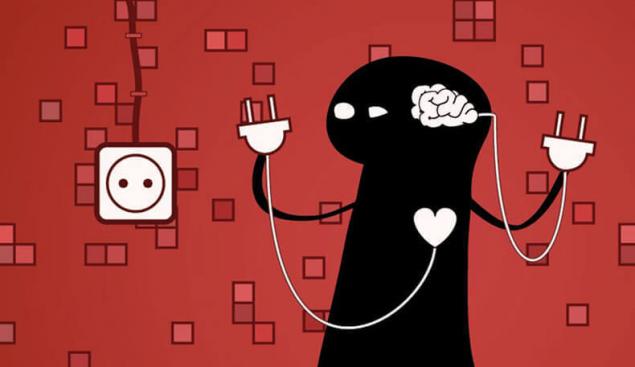571
Women, fire and other dangerous things
Cognitive linguistics is a new approach to the study of language which sees linguistic knowledge as part of General cognition and thinking; linguistic behavior is not separated from other General cognitive processes: thinking, memory, attention or learning, but understood as an integral part thereof. This trend emerged in the late 70's and early 80's, thanks primarily to the writings of John. Lakoff and R. Langacker.
One of the basic work in cognitive linguistics is a book by George Lakoff "Women, fire and dangerous things: what categories of language tell us about thinking" (Women, Fire, and Dangerous Things: What Categories Reveal about the Mind), published in 1987.

In this book Lakoff offers a new perspective on categorization as one of the basic cognitive operations.
In his study he draws on the work of Eleanor Roche (1978, Cognition and Categorization) that puts forth the theory of prototypes and basic level categories. The Rosh assumes that the similarity between members of a category are recognized more through sense perception, rather than logically determined.
For example, not all cups have handles and they are not all used for drinking. So, vessels without handles, are served in Chinese restaurants, and sports competitions are awarded cups (the cups) for sporting achievements.
Thus, the Rosh concludes that the meaning of the most everyday of concepts (or "natural categories") comes not from their defining properties, and from those characteristics that are common to their most typical member.
Developing this theory, Lakoff opposes in its work, the traditional view of the categories, "objectivism" and a new paradigm "experientialism".
The traditional view is that "objectivism", thinking is considered as a purely logical ability, dealing primarily with judgments that can be true or false. A new view proposed by cognitive linguists, explains that the thinking is "embodied", i.e. structures that form our conceptual system, have their source in our sensuous experience and are understood in its terms" [Lakoff, 2004, p.13]; our perception and description of this world is inextricably linked to the experience of our body.
The provocative title of the book caused much controversy, as for the Western reader women, fire and dangerous things, placed in the same group, are perceived as synonymous number.
This conclusion is based on the dominant view that things are grouped together in a category based on common characteristics. Further, in his analysis, the author tries to show the fallacy of this approach.
Lakoff emphasizes that categorization is one of the basic operations of thinking. Every time we talk about any subject or action, we resort to the help categories. Accordingly, "an understanding of how we approach categorization is necessary for understanding how we think and how we act, and therefore, necessary for the understanding of what makes us human beings." [Lakoff, 2004, p.20].
Here is an example from the book, which has already become a classic — the classification of things in the world that exists in the traditional version of dyirbal — the aboriginal language of Australia described by R. Dixon (Dixon 1982):
"Always, when in dyirbal the proposal used the noun must be preceded by a variant of one of four words: bayi, balan, balam, bala. With these words classify all objects in the universe of dyirbal, and to speak of dyirbal correctly, the speaker must use the right classifier before each name. Objects are divided into four categories.
I. Bayi: men, kangaroos, possums, a large part of snakes, most fishes, some birds, some insects, the moon, storms, rainbows, boomerangs, etc.
II. Balan: women, dogs, platypus, echidna, some snakes, some fishes, most birds, fireflies, Scorpions, crickets, the hairy caterpillar, all associated with water or fire, sun and stars, shields, etc.
III. Balam: all edible fruit and the plants on which they grow, tubers, ferns, honey, cigarettes, wine, cakes.
IV. Bala: parts of the body, meat, bees, wind, pointed sticks (weapons of the natives), some types of copies the most part of trees, grass, mud, stones, noises and language, etc.
In most cases, it is possible to trace the logical connection between the objects belonging to the same category. But often enough in one of the groups there are objects that, at first glance, do not apply directly to it.
Dixon revealed an interesting principle, which Lakoff refers to as "the principle of myth and faith": If a name has characteristic X (on the basis of which it should be assigned to some class), but a myth or belief is connected with characteristic y, then it is in the General case belong to the class correlated with y, but not to the class that correlated with Kh.
For example, birds are living beings, but they do not belong to the class I. Speaking of dyirbal believe that birds are souls of the dead women, so they are in class II." [Lakoff, 2004, p.130-131].

Thus, the object is placed into a category by basis, but rather relies on the experience of the speaker or his beliefs. The knowledge stemming from mythology overrides General knowledge.
"All this suggests that the responsibility for the inclusion of fire in that category, where the female carries the principle of field experience. This inclusion is carried out through the following links: women (via myth) associated with the sun, which (via the relevant area of expertise) is associated with fire. Similarly, you can tie danger and the water. Fire is dangerous, so dangerous things belong to the same category as fire. The water that extinguishes the fire, refers to the same scope of experience, and fire, and therefore is in the same category." [Lakoff, 2004, p. 131].
Lakoff notes that Dixon has achieved remarkable results. He showed that the fact that the Western view of man looks like a fantastic classification, from the point of view of people engaged in this classification is systematic and founded on strict principles with a way to categorize things.
This study opens up broad prospects for cognitive science because modifying the very notion of category, we change not only our concept of the mind, but also our understanding of the world.
On the one hand, we place the objects and phenomena of the world into different categories, thus creating a picture of the Universe that explains its structure for us. Learning other paintings worlds in foreign languages, we expand our own.
On the other hand, analyzing the operations of categorization and cognitive processes involved in them, we can better understand the functioning of our brains, and consequently ourselves. And this helps us achieve cognitive science, particularly cognitive linguistics.
The technique of "Drop" — the release of tension in relations with other people
The MYSTERY of co-optation
PS: This example is posed in the article title, just one of many in the book. For those interested in the topic I recommend to go to the source: the book is written in simple and accessible language gives food for thought about how our thinking, and its close connection with language.published
Author: Sophia Veretennikova
Source: lingvomaster.org/zensiny-ogon-i-drugie-opasnye-vesi
One of the basic work in cognitive linguistics is a book by George Lakoff "Women, fire and dangerous things: what categories of language tell us about thinking" (Women, Fire, and Dangerous Things: What Categories Reveal about the Mind), published in 1987.

In this book Lakoff offers a new perspective on categorization as one of the basic cognitive operations.
In his study he draws on the work of Eleanor Roche (1978, Cognition and Categorization) that puts forth the theory of prototypes and basic level categories. The Rosh assumes that the similarity between members of a category are recognized more through sense perception, rather than logically determined.
For example, not all cups have handles and they are not all used for drinking. So, vessels without handles, are served in Chinese restaurants, and sports competitions are awarded cups (the cups) for sporting achievements.
Thus, the Rosh concludes that the meaning of the most everyday of concepts (or "natural categories") comes not from their defining properties, and from those characteristics that are common to their most typical member.
Developing this theory, Lakoff opposes in its work, the traditional view of the categories, "objectivism" and a new paradigm "experientialism".
The traditional view is that "objectivism", thinking is considered as a purely logical ability, dealing primarily with judgments that can be true or false. A new view proposed by cognitive linguists, explains that the thinking is "embodied", i.e. structures that form our conceptual system, have their source in our sensuous experience and are understood in its terms" [Lakoff, 2004, p.13]; our perception and description of this world is inextricably linked to the experience of our body.
The provocative title of the book caused much controversy, as for the Western reader women, fire and dangerous things, placed in the same group, are perceived as synonymous number.
This conclusion is based on the dominant view that things are grouped together in a category based on common characteristics. Further, in his analysis, the author tries to show the fallacy of this approach.
Lakoff emphasizes that categorization is one of the basic operations of thinking. Every time we talk about any subject or action, we resort to the help categories. Accordingly, "an understanding of how we approach categorization is necessary for understanding how we think and how we act, and therefore, necessary for the understanding of what makes us human beings." [Lakoff, 2004, p.20].
Here is an example from the book, which has already become a classic — the classification of things in the world that exists in the traditional version of dyirbal — the aboriginal language of Australia described by R. Dixon (Dixon 1982):
"Always, when in dyirbal the proposal used the noun must be preceded by a variant of one of four words: bayi, balan, balam, bala. With these words classify all objects in the universe of dyirbal, and to speak of dyirbal correctly, the speaker must use the right classifier before each name. Objects are divided into four categories.
I. Bayi: men, kangaroos, possums, a large part of snakes, most fishes, some birds, some insects, the moon, storms, rainbows, boomerangs, etc.
II. Balan: women, dogs, platypus, echidna, some snakes, some fishes, most birds, fireflies, Scorpions, crickets, the hairy caterpillar, all associated with water or fire, sun and stars, shields, etc.
III. Balam: all edible fruit and the plants on which they grow, tubers, ferns, honey, cigarettes, wine, cakes.
IV. Bala: parts of the body, meat, bees, wind, pointed sticks (weapons of the natives), some types of copies the most part of trees, grass, mud, stones, noises and language, etc.
In most cases, it is possible to trace the logical connection between the objects belonging to the same category. But often enough in one of the groups there are objects that, at first glance, do not apply directly to it.
Dixon revealed an interesting principle, which Lakoff refers to as "the principle of myth and faith": If a name has characteristic X (on the basis of which it should be assigned to some class), but a myth or belief is connected with characteristic y, then it is in the General case belong to the class correlated with y, but not to the class that correlated with Kh.
For example, birds are living beings, but they do not belong to the class I. Speaking of dyirbal believe that birds are souls of the dead women, so they are in class II." [Lakoff, 2004, p.130-131].

Thus, the object is placed into a category by basis, but rather relies on the experience of the speaker or his beliefs. The knowledge stemming from mythology overrides General knowledge.
"All this suggests that the responsibility for the inclusion of fire in that category, where the female carries the principle of field experience. This inclusion is carried out through the following links: women (via myth) associated with the sun, which (via the relevant area of expertise) is associated with fire. Similarly, you can tie danger and the water. Fire is dangerous, so dangerous things belong to the same category as fire. The water that extinguishes the fire, refers to the same scope of experience, and fire, and therefore is in the same category." [Lakoff, 2004, p. 131].
Lakoff notes that Dixon has achieved remarkable results. He showed that the fact that the Western view of man looks like a fantastic classification, from the point of view of people engaged in this classification is systematic and founded on strict principles with a way to categorize things.
This study opens up broad prospects for cognitive science because modifying the very notion of category, we change not only our concept of the mind, but also our understanding of the world.
On the one hand, we place the objects and phenomena of the world into different categories, thus creating a picture of the Universe that explains its structure for us. Learning other paintings worlds in foreign languages, we expand our own.
On the other hand, analyzing the operations of categorization and cognitive processes involved in them, we can better understand the functioning of our brains, and consequently ourselves. And this helps us achieve cognitive science, particularly cognitive linguistics.
The technique of "Drop" — the release of tension in relations with other people
The MYSTERY of co-optation
PS: This example is posed in the article title, just one of many in the book. For those interested in the topic I recommend to go to the source: the book is written in simple and accessible language gives food for thought about how our thinking, and its close connection with language.published
Author: Sophia Veretennikova
Source: lingvomaster.org/zensiny-ogon-i-drugie-opasnye-vesi























